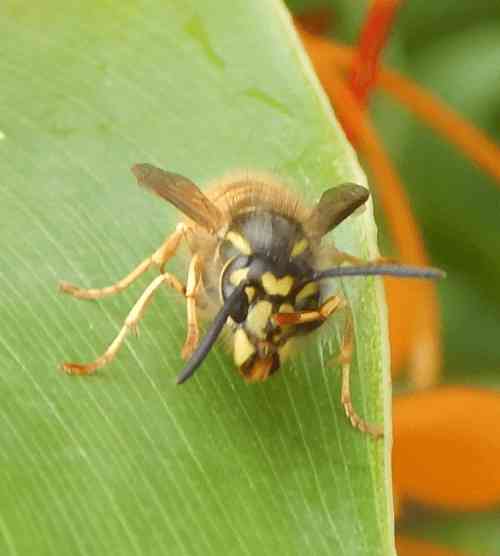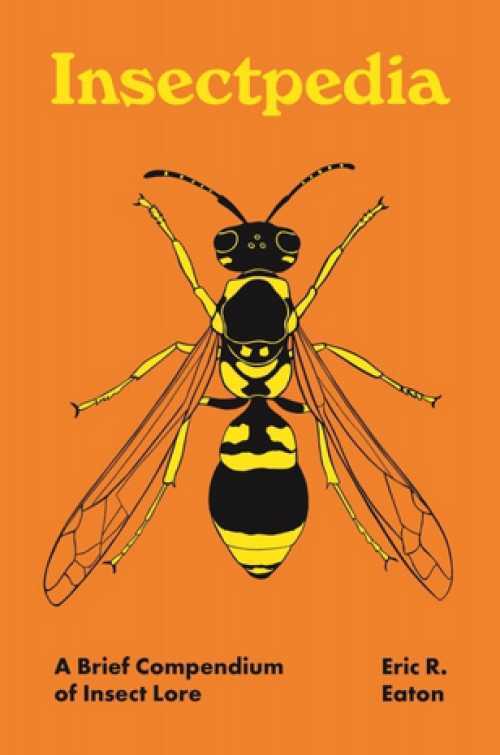Wasps And Yellowjackets
The term ‘yellowjacket’ is a phrase often used in the USA in reference to the type of yellow and black striped wasps that is sometimes an unwanted visitor to picnic tables.
However, the world of wasps is incredibly rich and diverse, and even with yellowjackets, it’s a little more complex than that, since it includes two genera (wasp types) and multiple species, rather than one particular species.
Here we will look at broad characteristics and ecology of some of the species of wasps that fall into the category ‘yellowjacket’.
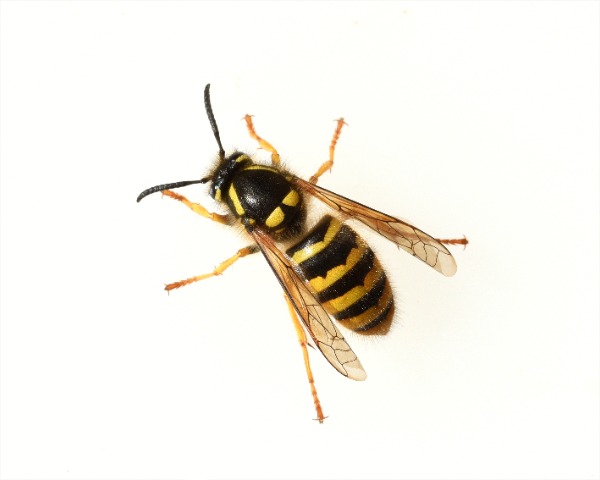 The common wasp Vespula vulgaris belongs in the category 'yellowjacet' - among others.
The common wasp Vespula vulgaris belongs in the category 'yellowjacet' - among others.Quick Facts About Yellowjackets
- Yellowjackets
include species within 2 wasp genera, and both genera belong in the wasp family
Vespidae.
- Some yellowjackets
are aerial nesters, others are cavity nesters.
- Whilst
yellowjackets are commonly thought of as unwelcome scavengers at refuse sites, outdoor
eating venues and picnics, not all yellowjackets exhibit such behaviour1, and
some – for example, the Bald-faced hornet, are predators of other yellowjackets2.
- In entomology, the term ‘yellowjacket’ is one word, although it is sometimes seen written as two.
What Is A Yellowjacket Wasp?
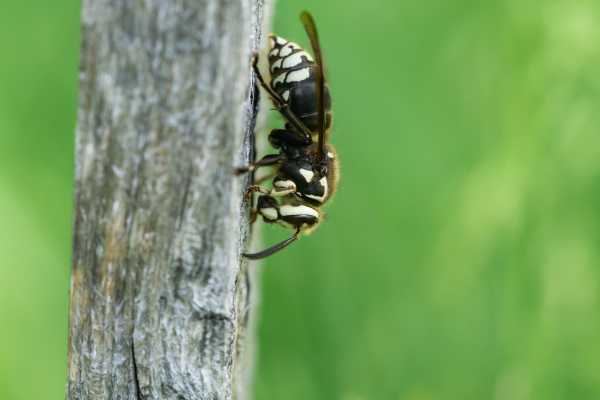 Dolichovespula maculata despite the common name of 'Bald-faced hornet', are a actually a type of yellowjacket wasp.
Dolichovespula maculata despite the common name of 'Bald-faced hornet', are a actually a type of yellowjacket wasp.A yellowjacket wasp is any wasp which belongs to either one of two wasp genera: Vespula and Dolichovespula1.
Interestingly, the term ‘yellowjacket’ also therefore includes the black and white Bald-faced hornet, which is in fact a wasp of the genus Dolichovespula rather than a true hornet3.
Likewise, a Vespula species, Vespula consobrina, is also black and white and is commonly called a 'Blackjacket'.
There are 19 species of yellowjackets in North America, 13 of which are Vespula species, the other 6 belonging to the genus Dolichovespula1.
Both Vespula and Dolichovespula construct nest cells from tiny slithers of layered wood and plant mattered gathered initially by the colony foundress, and then by workers.
Eggs are laid by the queen in hexagonal cells very much resembling the hexagonal cells of honeycomb made by honey bees (Apis species).
Vespula
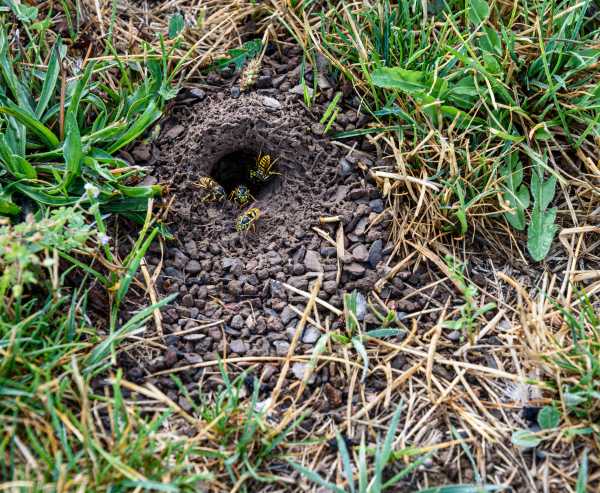 Entrance to the ground nest of yellowjacket of the Vespula genus
Entrance to the ground nest of yellowjacket of the Vespula genus
Vespula are cavity nesters. A suitable
cavity could be underground, for example an abandoned, underground rodent hole
or tree root cavity.
Alternatively, suitable cavities might be found in a roof space, a wall cavity, or even, as author of 'Wasps – The Astonishing Diversity Of A Misunderstood Insect', entomologist Eric R Heaton notes, the interior of a derelict vehicle4.
Whilst colonies of some yellowjacket species only last until autumn (after which, the colony will die and only new queens survive), in warmer regions, nests of some species can be perennial, each year growing ever larger until a nest becomes vast1 (see the table below).
A number of species are scavengers1, meaning they are adaptable and opportunistic in their food gathering habits.
This basically means that in addition to taking invertebrates and their larvae to feed to their own offspring, they will also seek to scavenge on human food waste, and at other resources, such as ripe fruit.
This behaviour may of course, raise concern among humans – see my advice about deterring wasps.
Other Vespula species are predators only, seeking out protein in the form of other invertebrates, and typically are less likely to visit places occupied by humans1.
The table below provides an overview of the colony characteristics and feeding behaviours of various Vespula species (adapted from Reed & Landolt1).
| Vespula species (and common name) | Foraging Behavior | Colony Size | Colony Decline* |
|---|---|---|---|
| Vespula germanica (German yellowjacket) | Predators and scavengers | 500–5,000 workers | Late September to early December |
| Vespula maculifrons (Eastern yellowjacket) | 500–15,000 cells | ||
| Vespula pensylvanica (Western yellowjacket) | Perennial colonies | ||
| Vespula alascensis (Common yellowjacket) | 100,000+ workers | ||
| Vespula flavopilosa (Downy yellowjacket) | 1 million cells | ||
| Vespula vulgaris (Common wasp) | 50,000–100,000 workers have been found in southern California, but in cooler climates, colony sizes are much smaller, typically fewer than 1,000 workers. | ||
| Vespula squamosa (Southern yellowjacket) | Predators and some scavengers | 500–4,000 workers | Late August to November |
| 500–10,000 cells | |||
| Vespula sulphurea (California yellowjacket) | Some perennial colonies | ||
| Vespula atropilosa (Prairie yellowjacket) | Strictly predators | 75–400 workers | Late August to September |
| Vespula acadica (Forest yellowjacket) | 500–2,500 cells | ||
| Vespula consobrina (Blackjacket) | No perennial colonies | ||
| * The period when reproductives emerge. | |||
Dolichovespula
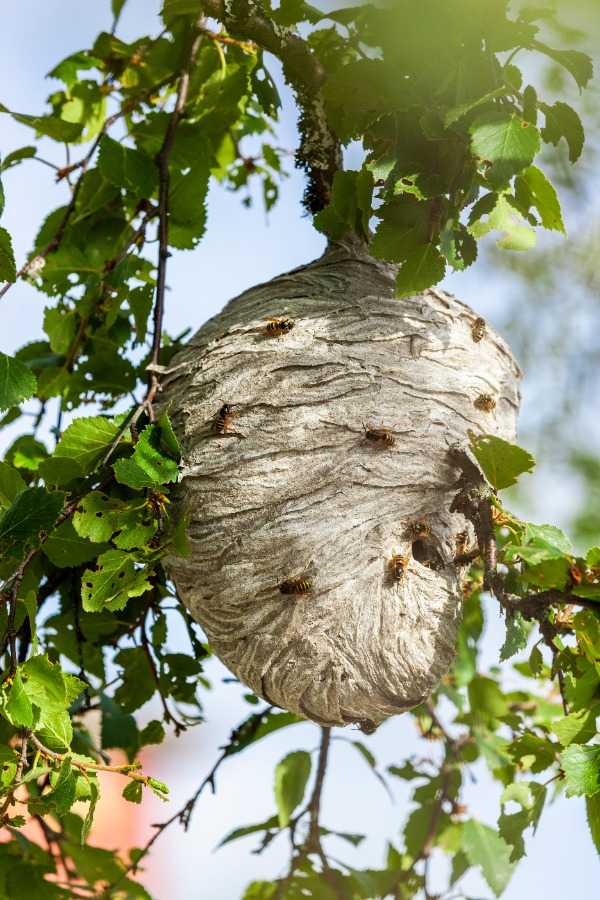 Yellowjacket wasps of the Dolichovespula typically suspend their nests from tree branches, buildings, or are found in shrubs.
Yellowjacket wasps of the Dolichovespula typically suspend their nests from tree branches, buildings, or are found in shrubs.Dolichovespula are aerial nesters.
Nests are typically found
hanging from the branches of trees and inside shrubs, (and are often found in
forests) but they may also be seen attached to buildings.
They typically start out as approximately egg-shaped, with an entrance hole at the bottom of the nest.
The table below provides an overview of the colony characteristics and feeding behaviours of two Dolichovespula species (adapted from Reed & Landolt1).
| Dolichovespula species (and common name) | Foraging Behavior | Colony Size | Colony Decline |
|---|---|---|---|
| Dolichovespula arenaria (Common aerial yellowjacket) | Strictly predators | 100–700 workers | Early July to September |
| 500–4,500 cells | |||
| Dolichovespula maculata (Bald-faced hornet) | No perennial colonies |
Yellowjacket Predators
All
yellowjacket species may be predated upon by birds (such as the bee-eater) and animals, as well as
other invertebrates, including other wasps.
They are also attacked by other parasitoid wasps, such as a genus of wasps called Bareogonalos4.
Most Bareogonalos are hyperparasitoids (i.e. they develop as hyperparasitoids in parasitoid wasps) which completes its lifecycle in yellowjackets and hornets4.
For example, a Bareogonalos species may lay more than 2,000 eggs on the leaves of plants, which are subsequently eaten by caterpillars. Yellowjackets or hornets may then feed the infected caterpillars to their own larvae, thus infecting their offspring with the parasite5.
References
1. Reed, Hal C. and Peter Landolt. “Ants, Wasps, and Bees (Hymenoptera).” Medical and Veterinary Entomology (2019): n. pag.
2. Enroth, Chris. Baldfaced Hornet: Dangerous bug or beneficial insect? University of Illinois Extension, College of Agricultural, Consumer & Environmental Sciences, February 2022 (Article).
4. Eric R. Heaton; Wasps – The Astonishing Diversity Of A Misunderstood Insect, Princeton University Press 2021.
5. Chang-Jun K, Jiang-Li T, Bong-Woo L, Seung-Hwan O, Moon-Bo C, Discovery of a trigonalid wasp, Bareogonalos xibeidai (Hymenoptera: Trigonalidae), reared from nests of Vespula koreensis koreensis (Hymenoptera: Vespidae) in South Korea, Journal of Asia-Pacific Biodiversity, https://doi.org/10.1016/j.japb.2020.06.006.
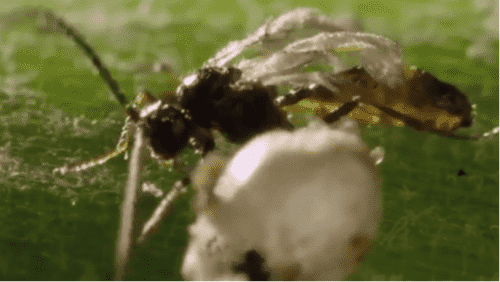
Body Snatcher Wasps!
Why are farmers turning to wasps to help them control crop eating pests?
If you found this page helpful or interesting, I'd really be grateful if you would share it with others - if not this page, perhaps another, such as Gardening For Bees.
Thank you so much :) .
